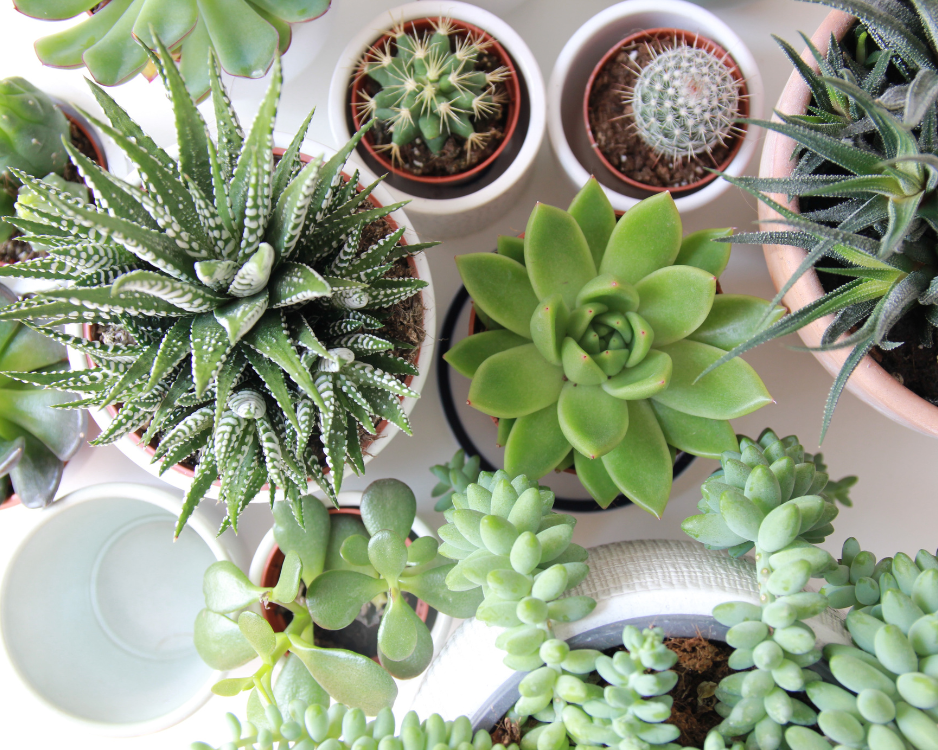
Succulent Care Simplified: Mastering the Art of Watering
Introduction:
Succulents, with their alluring shapes and varied textures, have become a favourite for plant enthusiasts and casual gardeners alike. These resilient plants are often celebrated for their low maintenance, especially when it comes to watering. However, understanding the right balance of moisture for these desert natives is key to their survival and thriving. This comprehensive guide will help you demystify the frequency and techniques of watering succulents, ensuring your beloved plants enjoy a long and healthy life.
- Understanding Succulent Water Needs:
The Basics of Succulent Hydration: Succulents store water in their leaves, stems, or roots, which allows them to survive in arid conditions. This unique adaptation means they require less frequent watering compared to other houseplants.
Seasonal Variations: The watering needs of succulents change with the seasons. During their active growing season (usually spring and summer), they need more water. In the dormant period (fall and winter), they require much less.
- Signs of Watering Needs:
Underwatering Indicators: If a succulent is under watered, its leaves may appear shrivelled, dry, or crispy. The plant may also start to drop leaves or show signs of wilting.
Overwatering Symptoms: Overwatering is a common issue with succulents. Symptoms include soft, mushy leaves, discoloration, and rot at the base of the plant. Overwatered succulents are also prone to root rot.
- How Often to Water Succulents:
General Rule of Thumb: A common guideline is to water succulents once every 1-2 weeks during the growing season and reduce to once a month or less during dormancy. However, these frequencies can vary based on several factors.
Factors Influencing Watering Frequency:
- Climate: In humid climates, succulents will need less frequent watering. In dry climates, they may need more.
- Season: Water more frequently in warm, growing months and less in the cooler, dormant period.
- Indoor vs. Outdoor: Indoor succulents generally require less frequent watering than those outdoors.
- Pot Size and Type: Smaller pots dry out faster than larger ones. Terracotta pots, which are porous, allow soil to dry more quickly than plastic or glazed ceramic pots.
- Soil Type: Well-draining succulent or cactus mix is ideal and will influence watering frequency.
- The Right Way to Water Succulents:
Deep Watering Technique: When you water, do it thoroughly. The soil should be soaked until water runs out of the drainage holes. This encourages deep root growth and healthy plants.
Avoid Watering the Leaves: Water the soil directly, keeping the leaves dry to prevent rot and fungal diseases.
Let the Soil Dry Completely: Before watering again, ensure the soil is completely dry. You can check by sticking your finger about an inch into the soil; if it’s dry, it’s time to water.
- Special Considerations for Potted Succulents:
Drainage is Key: Always use pots with drainage holes to prevent water from accumulating
at the bottom.
Choosing the Right Pot: Apart from drainage, the material of the pot can affect how quickly the soil dries. Terracotta and clay pots are breathable and help the soil dry out faster, making them ideal for succulents.
Potting Mix: Use a well-draining succulent or cactus mix. You can also make your own by mixing potting soil with sand and perlite or pumice for added drainage.
- Watering Newly Planted Succulents:
Initial Care: Newly planted or repotted succulents should be watered sparingly until they establish roots. This usually takes about a week. Overwatering during this period can increase the risk of root rot.
Monitoring Growth: Keep a close eye on new succulents for signs of distress, and adjust your watering schedule accordingly.
- Adapting to Environmental Changes:
Seasonal Adjustments: As seasons change, so should your watering schedule. Reduce frequency in fall and winter, and increase in spring and summer.
Climate Considerations: In hot, dry climates, succulents may need more frequent watering. In cooler, humid climates, they may need less.
- Troubleshooting Common Issues:
Overwatering Recovery: If you’ve overwatered a succulent, let the soil dry out completely before watering again. If there’s signs of rot, you may need to remove the affected parts and repot the plant in fresh, dry soil.
Reviving Underwatered Succulents: Gradually increase watering for an underwatered succulent. Do not flood it with water suddenly, as this can shock the plant.
Pest and Disease Management: Overwatering can lead to pests and diseases. Keep an eye out for signs of infestations and treat promptly with appropriate measures.
- The Art of Watering Different Types of Succulents:
Varietal Needs: Not all succulents are created equal. For instance, cacti generally require less water than other succulents. Research the specific needs of your succulent types.
Creating a Watering Schedule: Group succulents with similar watering needs together to simplify your watering routine.
- Utilising Tools and Technology:
Moisture Metres: These tools can help take the guesswork out of watering by measuring the moisture level of the soil.
Automated Systems: For those with large collections or limited time, drip irrigation systems or self-watering pots can be a lifesaver.
- Enjoying Your Succulents:
Watering succulents correctly is key to their growth and beauty. Enjoy the process of learning and observing your plants. Each succulent has its unique characteristics and watching them flourish is part of the joy of gardening.
- Conclusion:
Mastering the art of watering succulents is a balance of understanding their natural habitat, observing your specific environmental conditions, and adapting your care routine accordingly. Remember, less is often more when it comes to watering these resilient plants. With patience and practice, you’ll develop a sense for when your succulents are thirsty, ensuring a thriving, vibrant collection.





Leave a comment